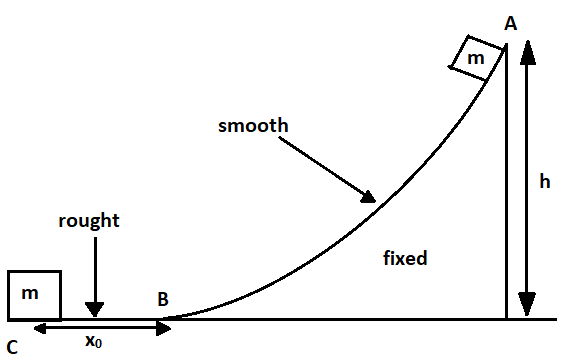
Work done by normal reaction is zero during the motion of the block:

A) From point A to B only
B) From point B to C only
C) From A to C
D) None of these
Answer
218.7k+ views
Hint: In order to solve this question you have to remember the concepts of the work-energy theorem and the use of force for finding work done. The work-energy theorem states that the work done by all the forces that are acting on a particle will be equal to the change in the kinetic energy of that particle.
Complete step by step solution:
In the question, it is given a small block of mass m, which is released from point A on a fixed smooth wedge as shown in the above figure. The top of the wedge is marked as A and the bottom as B and at point C the block stops moving because of the roughness of the floor.
We have to find the portion where the work done by the normal reaction is zero during the motion of the block
We already know that the normal reaction is always perpendicular to the direction of motion.
So, it means that the work done by the normal reaction is equal to zero from point A to C as the normal reaction is perpendicular to the displacement of the block.
Hence, from the above discussion, it is clear that the work done by the normal reaction is zero during the motion of the block will be from point A to C.
Therefore, the correct option is (C).
Note: Always keep in mind that the normal reaction is the force that is applied by the surface in reaction to the weight that the object exerts on the surface. The normal reaction force is perpendicular to the surface that an object contacts. For example, the table surface that prevents an object from falling from the table.
Complete step by step solution:
In the question, it is given a small block of mass m, which is released from point A on a fixed smooth wedge as shown in the above figure. The top of the wedge is marked as A and the bottom as B and at point C the block stops moving because of the roughness of the floor.
We have to find the portion where the work done by the normal reaction is zero during the motion of the block
We already know that the normal reaction is always perpendicular to the direction of motion.
So, it means that the work done by the normal reaction is equal to zero from point A to C as the normal reaction is perpendicular to the displacement of the block.
Hence, from the above discussion, it is clear that the work done by the normal reaction is zero during the motion of the block will be from point A to C.
Therefore, the correct option is (C).
Note: Always keep in mind that the normal reaction is the force that is applied by the surface in reaction to the weight that the object exerts on the surface. The normal reaction force is perpendicular to the surface that an object contacts. For example, the table surface that prevents an object from falling from the table.
Recently Updated Pages
Two discs which are rotating about their respective class 11 physics JEE_Main

A ladder rests against a frictionless vertical wall class 11 physics JEE_Main

Two simple pendulums of lengths 1 m and 16 m respectively class 11 physics JEE_Main

The slopes of isothermal and adiabatic curves are related class 11 physics JEE_Main

A trolly falling freely on an inclined plane as shown class 11 physics JEE_Main

The masses M1 and M2M2 M1 are released from rest Using class 11 physics JEE_Main

Trending doubts
JEE Main 2026: Application Form Open, Exam Dates, Syllabus, Eligibility & Question Papers

Understanding Uniform Acceleration in Physics

Derivation of Equation of Trajectory Explained for Students

Hybridisation in Chemistry – Concept, Types & Applications

Understanding the Angle of Deviation in a Prism

Understanding Collisions: Types and Examples for Students

Other Pages
JEE Advanced Marks vs Ranks 2025: Understanding Category-wise Qualifying Marks and Previous Year Cut-offs

Units And Measurements Class 11 Physics Chapter 1 CBSE Notes - 2025-26

NCERT Solutions For Class 11 Physics Chapter 8 Mechanical Properties Of Solids

Motion in a Straight Line Class 11 Physics Chapter 2 CBSE Notes - 2025-26

NCERT Solutions for Class 11 Physics Chapter 7 Gravitation 2025-26

Understanding Atomic Structure for Beginners




